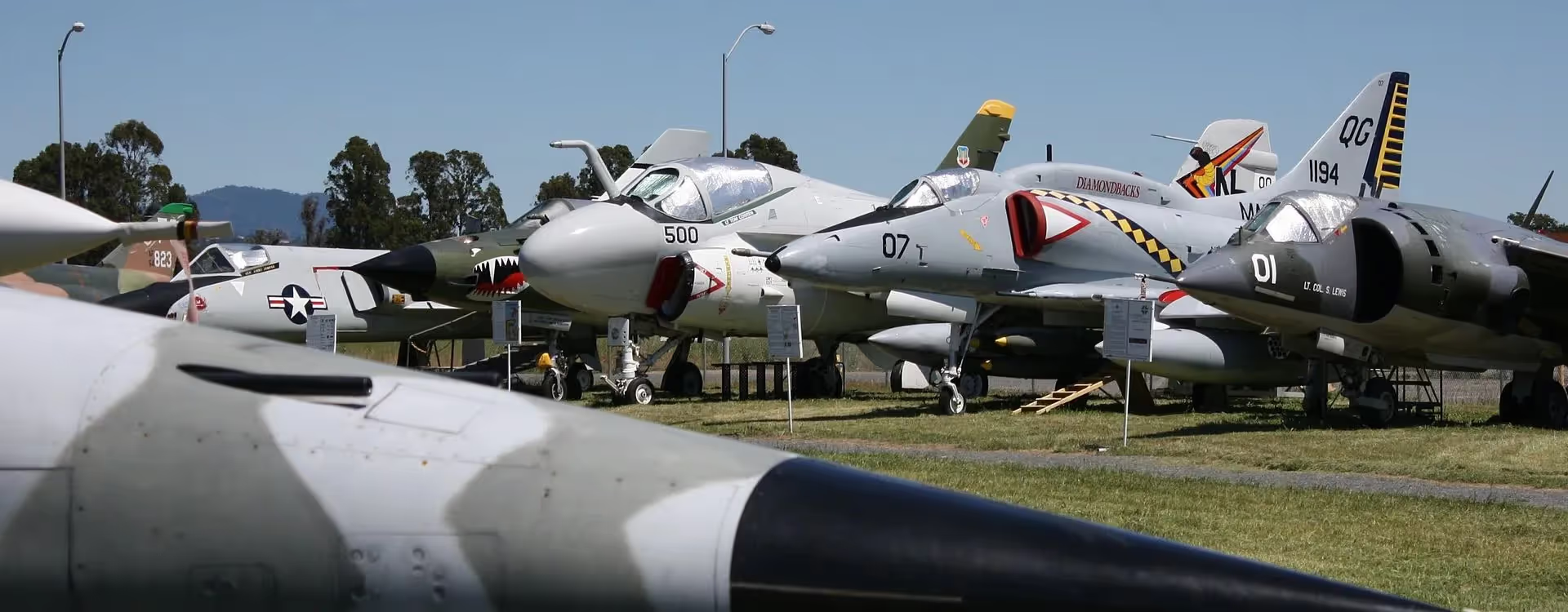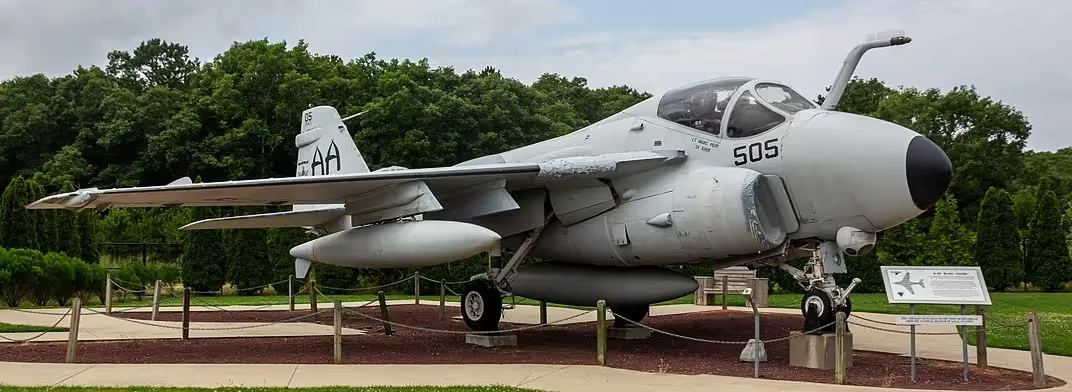Warplanes of the USA: Grumman A-6 Intruder
Grumman A-6 Intruder

(USN Photo)
A U.S. Navy Grumman A-6E Intruder aircraft (BuNo 160998) from Attack Squadron 34 Blue Blasters, Carrier Air Wing 7 (CVW-7), navigates over the Spanish countryside during a low level training mission in support of Exercise MATADOR, a combined/joint US and Spanish exercise.
The Grumman A-6 Intruder is an American twinjet all-weather attack aircraft developed and manufactured by American aircraft company Grumman Aerospace and formerly operated by the U.S. Navy and U.S. Marine Corps. It was designed in response to a 1957 requirement issued by the Bureau of Aeronautics for an all-weather attack aircraft for Navy long-range interdiction missions and with short takeoff and landing (STOL) capability for Marine close air support. It was to replace the piston-engined Douglas A-1 Skyraider. The requirement allowed one or two engines, either turbojet or turboprop.
The winning proposal from Grumman used two Pratt & Whitney J52 turbojet engines. The Intruder was the first Navy aircraft with an integrated airframe and weapons system. Operated by a crew of two in a side-by-side seating configuration, the workload was divided between the pilot and weapons officer (bombardier/navigator or BN). In addition to conventional munitions, it could also carry nuclear weapons, which would be delivered using toss bombing techniques. On 19 April 1960, the first prototype made its maiden flight.
The A-6 was in service with the United States Navy and Marine Corps between 1963 and 1997, during which time multiple variants were prototyped and produced. Two of the more successful variants developed were the EA-6B Prowler, a specialized electronic warfare derivative, and the KA-6D tanker version.[2] It was deployed during various overseas conflicts, including the Vietnam War and the Gulf War. The A-6 was intended to be superseded by the McDonnell Douglas A-12 Avenger II, but this program was ultimately canceled due to cost overruns. Thus, when the A-6E was scheduled for retirement, its precision strike mission was initially taken over by the Grumman F-14 Tomcat equipped with a LANTIRN pod. (Wikipedia)

(USN Photo)
A U.S. Navy Grumman A-6B Intruder (BuNo 149955) of Attack Squadron VA-34 Blue Blasters at Davis-Mothan Air Force Base, Arizona (USA), in 1976. VA-34 was assigned to Carrier Air Wing 1 (CVW-1) aboard the aircraft carrier USS John F. Kennedy (CV-67). The A-6A 149955 was converted to an to A-6B and was retired to the MASDC as 5A0003 on 12 March 1976. It was later returned to service and converted to an A-6E. The aircraft was finally retired to the AMARC as 5A0229 on 21 November 1996 and scrapped in 2002.
-242_1975.avif)
(USMC Photo)
Four U.S. Marine Corps All-Weather Medium Attack Squadron 242 (VMA(AW)-242) Grumman A-6A Intruder aircraft (BuNo 155623, 155624, 155625, 157014) flying in echelon formation on 21 November 1975.

(USN Photo)
A KA-6D Intruder aircraft from attack squadron VA-34 Blue Blasters refuels a Fighter Squadron 142 (VF-142) F-14A Tomcat aircraft in flight during an air show off the coast of Caracas, Venezuela. The aircraft were assigned to the nuclear-powered aircraft carrier USS DWIGHT D. EISENHOWER (CVN 69).

(USN Photo)
A U.S. Navy Grumman A-6E Intruder aircraft assigned to the Sunday Punchers of attack squadron VA-75 makes ready for launch from the number one catapult, during carrier qualifications aboard the US Navy's nuclear powered aircraft carrier USS ENTERPRISE (CVN 65). Enterprise is participating in Combined Joint Task Force Exercise '96, as part of a multinational force of over 50,000 soldiers, sailors, airman and marines from Canada, Britain and the United States.
_on_22_July_1996_(6526829).avif)
(USN Photo)
Virginia Governor George Allen (center white vest) launches the final Grumman A-6E Intruder (BuNo 160998) from the flight deck of aircraft carrier USS George Washington (CVN-73) on 22 July 1996. Crewed by U.S. Navy Captain Kolin M. Jan, Commander Carrier Air Wing 7 (CVW-7), and Commander David Buss, Commanding Officer Attack Squadron 34 (VA-34) "Blue Blasters", the aircraft was the last to launch from the deck of George Washington after a deployment to the Arabian Gulf and Mediterranean Sea from 26 January to 23 July 1996. This was the final deployment for VA-34 flying the A-6 Intruder. The squadron began training on the McDonnell Douglas F/A-18C Hornet aircraft shortly after its return.

(USN Photo)
A U.S. Navy Grumman KA-6D Intruder (BuNo 149484) from Attack Squadron 34 (VA-34) "Blue Blasters" in flight. VA-34 was assigned to Carrier Air Wing 7 (CVW-7) aboard the aircraft carrier USS Dwight D. Eisenhower (CVN-69) for a deployment to the Mediterranean Sea from 29 February to 29 August 1988.
_1983.avif)
(USN Photo)
A U.S. Navy Grumman A-6E Intruder from Attack Squadron VA-34 Blue Blasters landing on the aircraft carrier USS America (CV-66). VA-34 was assigned to Carrier Air Wing 1 (CVW-1) aboard the America for a deployment to the Mediterranean Sea and the Indian Ocean from 7 December 1982 to 2 June 1983.
.avif)
(USN Photo)
A U.S. Navy Grumman A-6E Intruder (BuNo 155670) aircraft from Attack Squadron 52 (VA-52) "Knightriders" in flight in 1981. VA-52 was assigned to Carrier Air Wing 15 (CVW-15) aboard the aircraft carrier USS Kitty Hawk (CV-63) from 1 April to 23 November 1981 for a deployment to the Western Pacific. Note: The date given (15 January 1984) has to be incorrect, as BuNo 155670 was assigned to VA-52 for the 1981 cruise. In 1984 CVW-15 was also assigned to the USS Carl Vinson (CVN-70). 155670 was an A-6A modified to an A-6E. After its retirement it was sunk as an artificial reef

(RuthAS Photo)
Virginia Governor George Allen (center white vest) launches the final Grumman A-6E Intruder (BuNo 160998) from the flight deck of aircraft carrier USS George Washington (CVN-73) on 22 July 1996. Crewed by U.S. Navy Captain Kolin M. Jan, Commander Carrier Air Wing 7 (CVW-7), and Commander David Buss, Commanding Officer Attack Squadron 34 (VA-34) "Blue Blasters", the aircraft was the last to launch from the deck of George Washington after a deployment to the Arabian Gulf and Mediterranean Sea from 26 January to 23 July 1996. This was the final deployment for VA-34 flying the A-6 Intruder. The squadron began training on the McDonnell Douglas F/A-18C Hornet aircraft shortly after its return.

(USN Photo)
A U.S. Navy Grumman A-6B Intruder (BuNo 151558) from Attack Squadron VA-95 Green Lizards on the ground at Naval Air Station Miramar, California (USA) on 15 June 1974. VA-95 was assigned to Carrier Air Wing 15 (CVW-15) aboard the aircraft carrier USS Coral Sea (CVA-43).
.avif)
(USN Photo)
A Grumman A-6A Intruder (then designated A2F-1) with an array of possible ordnance in 1962. Outside ring: in front of the A-6 are five mock-ups of multiple ejector racks. To the right and left are 46 Mk 81 113 kg (250 lb) bombs. The circle is closed by 30 Mk 82 227 kg (500 lb) bombs. Second ring: In front of the plane are "five classified shapes" (napalm canisters and/or nuclear weapons?). To the right 13 LAU-10 rocket launchers with four 12.7 cm (5 in) Zuni rockets each are arrayed, on the opposite side 13 Aero 7D (LAU-3/A) rocket launchers with 19 7 cm (2.75 in) are displayed. To the right and left of the horizontal stabilizers are 15 Mk 83 454 kg (1.000 lb) bombs, and 12 Mk 79 fire bombs are displayed behind the aircraft. Inner ring: behind the left wing (with the national insignia) are three Aero 8A practice bomb containers, on the opposite side five Mk 84 907 kg (2.000 lb) bombs are displayed. In front of the left wing are five AGM-12A Bullpup air-to-ground missiles, in front of the right wing are four AIM-9B Sidewinder air-to-air missiles and a Douglas D-704 Buddy-Buddy refueling tank with extendable snorkel (a.k.a. Buddy Store). The aircraft itself carries four 1.137 l (300 gal) tanks.
Grumman A-6 Intruders preserved in the USA
YA-6A

(Staff Sergeant Jomp, USMC Photo)
Grumman EA-6A Intruder (BuNo. 147865) from Marine electronic countermeasures squadron VMAQ-2 Playboys flying over Marine Corps Air Station Cherry Point, North Carolina, 1 Dec 1978.
147865 – Cherry Point Historical Aircraft Park, Havelock, North Carolina; displayed as an EA-6A. CY-00.
147867 – Alleghany Arms & Armory Museum, Smethport, Pennsylvania.


(David Foltz Photos)
148618 - Key West Naval Air Facility, Florida.
KA-6D
149482 – NAS Whidbey, Oak Harbor, Washington; displayed as an A-6E. Mounted on pylons.

(APK Photo)
.avif)
(GreaterPonce665 Photo)
151826 – Battleship Memorial Park, Mobile, Alabama.
.avif)
(Bill Abbott Photo)
.avif)
(Alan Wison Photo)

(Mys 721tx Photo)
152910 – Oakland Aviation Museum, Oakland, California.
A-6E

(USN Photo)
.avif)
(Clemens Vasters Photo)
.avif)
.avif)
(Eddie Maloney Photos)

(Greg Goebel Photo)
151782 – USS Midway Museum, San Diego, California.
152599 – Patriots Point Naval & Maritime Museum, Mount Pleasant, South Carolina.
152599 – Richmond Municipal Airport, Richmond, Indiana.

(Articseahorse Photo)

(Articseahorse Photo)
152907 – NAS Whidbey, Oak Harbor, Washington.

(NMNA Photo)
152923 – Norfolk Naval Station/Chambers Field (former NAS Norfolk), Norfolk, Virginia.
.avif)
.avif)
(Doug Kerr Photos)
152935 – Empire State Aerosciences Museum, Glenville, New York.

(Skytamer.com, Peter S. Kuntz Photos)
152936 – United States Naval Museum of Armament and Technology, NCC China Lake(North), Ridgecrest, California.


(Author Photos)
154131 – Walker Field Colorado Park, Grand Junction, Colorado.
.avif)
(Edward O'Connor Photo)
154162 – Palm Springs Air Museum, Palm Springs, California.


(Balon Greyjoy Photos)
.avif)
(Gary Todd Photo)
154167 – Steven F. Udvar-Hazy Center, NASM, Washington, D.C.

(Curimedia Photo)

(Author Photo)
154170 – Flying Leatherneck Aviation Museum, MCAS Miramar, San Diego, California.
.avif)
.avif)
(Bill Abbot Photos)
154171 – Estrella Warbird Museum, Paso Robles, California.

(Crabtree13 Photo)
155595 – Pacific Coast Air Museum, Santa Rosa, California.

(Tomas Del Coro Photo)
155610 – National Naval Aviation Museum, NAS Pensacola, Pensacola, Florida.

(Left Coast Labs Photo)
155627 – NAS Fallon, Fallon, Nevada.
155629 – Hickory Aviation Museum, Hickory, North Carolina.

(kitmasterbloke Photo)
155644 – Yanks Air Museum, Chino, California.

(Thomson200 Photo)
155648 – Aviation History & Technology Center, Dobbins ARB (formerly Atlanta NAS), Atlanta, Georgia.
155661 – Camp Blanding Museum and Memorial Park. (Aslo reported as 155851).

(Author Photo)

(aeroprints.com Photo)
155713 – Pima Air & Space Museum (adjacent to Davis-Monthan AFB), Tucson, Arizona.

(AviationPhotographer Photo)

(Balon Greyjoy Photo)
156997 – Patuxent River Naval Air Museum, NAS Patuxent River, Lexington Park, Maryland. Bureau Number 156997, was original an A-6A that first flew in December 1969. It was converted to an A-6E and flew in the VX-5 operational test squadron. It was transferred to the Naval Air Test Center's Strike Air Test Directorate at Patuxent River in October 1984, and was retired on July 29, 1993. It came to the museum in April 1995. It was 4,789 flight hours, 780 catapult launches, 787 arrested landing, and 6,287 total landings.
157001 – Naval Inventory Control Point, Philadelphia, Pennsylvania.
157024 – Defense General Supply Center, Richmond, Virginia.
.avif)
.avif)
(Alan Wilson Photos)
158532 – USS Lexington Museum, Corpus Christi, Texas.


(Articseahorse Photos)

(Frank Kovalchek Photo)
158794 – Museum of Flight, Seattle, Washington.

(Dark Friday Photo)
159567 – Naval Surface Warfare Center Dahlgren Division, Dahlgren, Virginia.
159568 – Patuxent River NAS, Lexington Park, Maryland.
159579 – Castle Air Museum, Atwater, California.
159901 – NAF El Centro, El Centro, California.
.avif)
(Alan Wilson Photo)
160995 – Yanks Air Museum, Chino, California.
161676 – Lycoming County Veterans Memorial Park, Williamsport, Pennsylvania.
.avif)
(ZLEA Photo)
162182 – Valiant Air Command Warbird Museum, Space Coast Regional Airport, Titusville, Florida.
162195 – San Diego Aerospace Museum, San Diego, California.
162206 – Oregon Air and Space Museum, Eugene, Oregon.
164378 – Eastern Carolina Aviation Exhibit, Havelock, North Carolina.

(The Wordsmith Photo)


(Mike Peel Photos)
164384 – Grumman Memorial Park, Long Island, New York.
A-6F
162184 – Cradle of Aviation Museum, Garden City, New York.

(NotLessOrEqual Photo)
162185 – Intrepid Sea-Air-Space Museum, New York City, New York.






